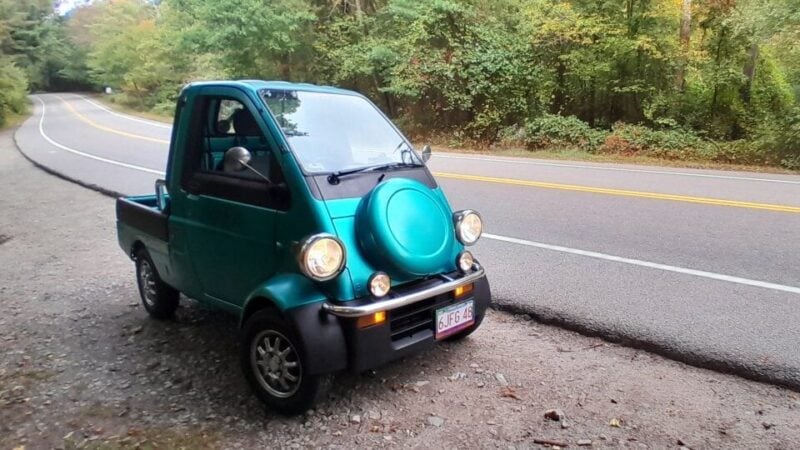
As we’ve seen over the years, GTPlanet’s members are a bunch of car enthusiasts at heart. Whether they own something fast or expensive or not, they do love their cars — and a large proportion have had that enthusiasm cultivated by Gran Turismo.
For those who’ve grown up with the GT series, their likes and dislikes have been guided by what they’ve seen and driven in the games. Every now and then one will make an adult-life decision to spend thousands of dollars on a car because they got attached to it through Gran Turismo.
Obelisk is one such member, and he’s gone out and spent his own money on bringing one of the strangest, coolest, and most-beloved cars in the history of the series across the Pacific Ocean for a new life in the United States.
We’ll hand you over to him and his thoughts, as he reviews his new ride and recaps the circumstances of his truly weird purchase: a 1996 Daihatsu Midget.
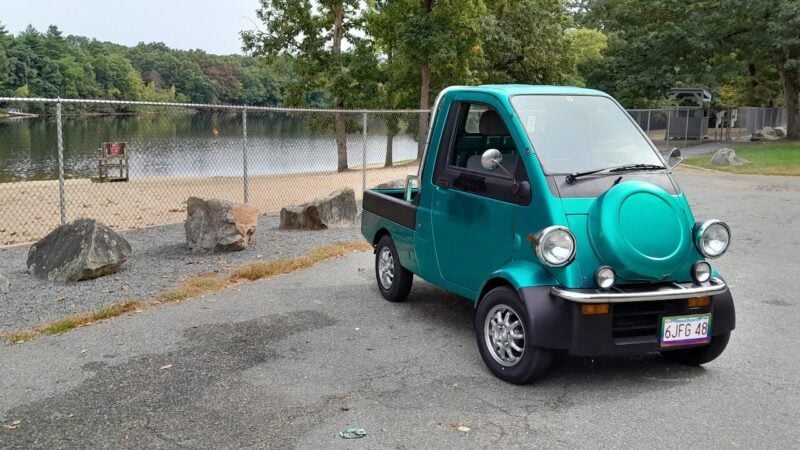
What is it?
Kei cars are a unique and fascinating category of cars, a testament to clever engineering and design within major legal and practical constraints. Initially created due to the Japanese government seeking to stabilize and grow its domestic car industry, the keijidosha (“compact automobile”) segment has grown into a significant force in Japan’s automotive world: kei cars account for almost 35% of all new car purchases in 2023.
Many of these diminutive cars, particularly the ones born in the beginning of the 660cc era, shot to global fame in the late 1990s and early 2000s thanks to being featured in Gran Turismo 2 and subsequent games in the series.
Their reputations were cemented in-game due to low costs, very solid early-game performance, and their unique appearances; some may recall a silver Cappuccino featuring heavily in a series of challenge playthroughs on YouTube for these exact reasons.
One kei car in particular that many players will remember is a stark contrast to most of the other options featured in the franchise: a tiny pick-up truck with an unusual design, built for utility and function above all else.
A humble machine, then; one not meant for heavy track use, but presented as a contextual footnote for the more exotic options within the segment — some might even argue it was intended as a joke. Regardless of the reasons behind its inclusion, the Daihatsu Midget II has become an icon of the Gran Turismo franchise.
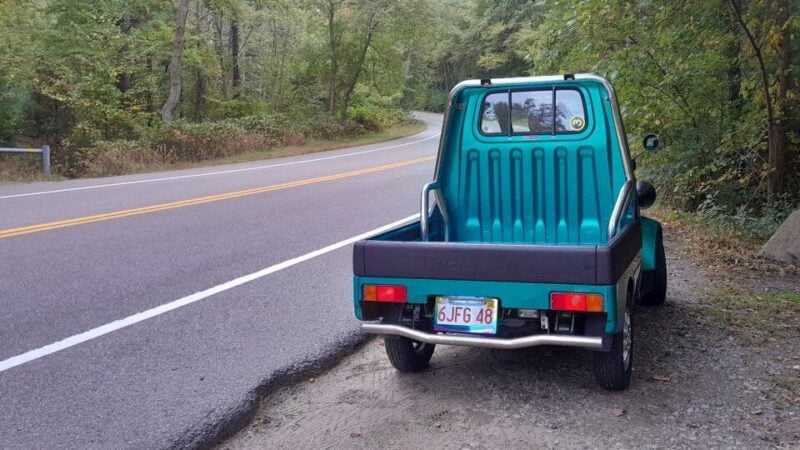
How Did I Get Mine, and Why?
Midget IIs, due to their low volume, don’t have a lot of reach or value in real life. Because of that, they end up skipped over for more practical kei trucks such as their concurrent sibling, the Hijet. Consequently, surviving Midget IIs are often available in surprisingly high volume on used car marketplaces
For those of you unfamiliar with Gran Turismo, an old truck like this might seem like a rather strange car to pursue. So, why would I go out of my way to get one?
To simplify a long story, I grew up on Gran Turismo. My first GT game was a rental copy of GT2 when I was around 8 or 9. And as I grew up, GT4 became my go-to game for a very long time. During the PS3 era, and especially during the peak of GT6 circa 2014 or 2015, I started to really fall in love with all of the off-kilter car choices that were included in the game’s expansive roster.
At some point, I wound up buying a Midget II for one of the Seasonal events (a five-lap sprint on Suzuka East). It performed way better than it should have, which drew my attention to the strange little pickup. That moment sparked a decade-long obsession that eventually came to a head in April of this year. I had a perfect opportunity to own a dream car and a piece of Gran Turismo history, and I finally had a clear path to making it happen.
So I did.
It took a few attempts to get one through Car from Japan, mostly due to others blind-buying the cars I’d been contacting the sellers about. After some time and discussion with the (very helpful) website staff, I ended up purchasing and importing the Midget II pickup that this article is about.
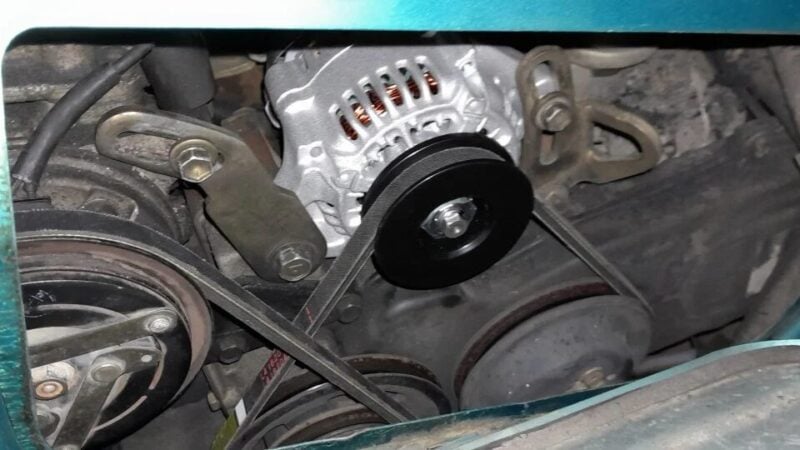
What Makes it Go?
All early Daihatsu Midget IIs (1996-1997) came equipped with a naturally aspirated inline 3 known as the EF-CK. Following a change in regulations in 1998, the later model year Midgets would receive an upgraded engine known as the EF-SE with electronic fuel injection.
These engines are variants of Daihatsu’s EF series that are exclusive to the Midget II, producing less power compared to other variants in exchange for more torque at lower rev ranges. Consequently, when the EF-CK engine in our example Midget is coaxed to full power, it will only produce a meager 31hp and 37lbft of torque.
It’s certainly not an inspiring amount of power, since it hits max output well before its redline of 6,500rpm. You’re forced to rev it out to keep pace with traffic, meaning you spend a good portion of your time with the engine struggling to produce meaningful power.
As a result, both the four-speed manual that the review example has and the alternate three-speed automatic available as an option – both of which send power to the rear wheels – are geared as short as reasonably possible to allow the Midget II to operate without bogging down.
This leads to some rather interesting results, as first gear on the four-speed is completely spent at a mere 25km/h (15mph), and second/third gear are just about as short at 45km/h (28mph) and 65 km/h (40mph) respectively. You will find yourself having gone through the entire gearbox simply from hustling the little machine to the speed limit on any typical American intrastate route.
The Midget will ultimately struggle its way up to a top speed of 109km/h (68mph) in ideal conditions. Should the conditions be less than perfect, however, expect a lower top speed. I would strongly advise against any attempt to take a Midget II to these speeds as it requires being on wide-open throttle at redline in fourth gear, which can be quite taxing on the 28-year old engine.
This does come with an upside, though: this car has remarkable fuel economy. In the right hands, it can sip gas at a hybrid-challenging 24.5km/l (58mpg), and combined with a surprisingly small six-gallon (22-liter) gas tank, you can get 348 miles to a tank.
That’s comparable to many modern cars but at a fraction of the cost per refill. At time of writing the, my last tank of petrol was $15, compared to $45 in a Miata…
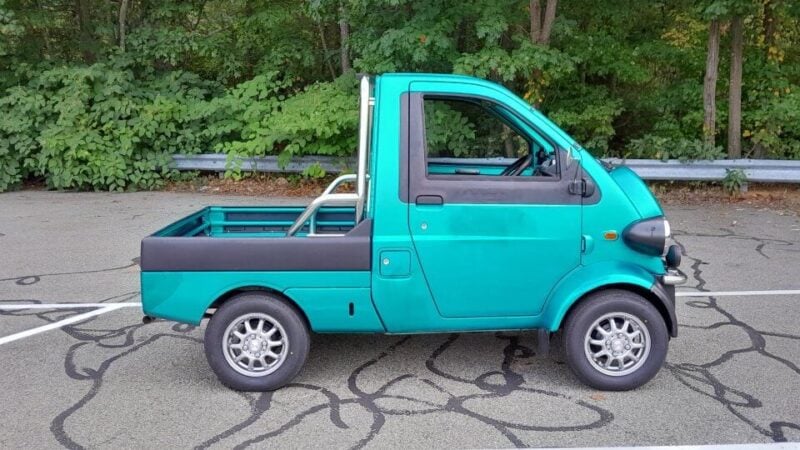
What Did I Need to Do to Get it Road-Ready?
I’m going to simplify the process here, but this car needed some work to be road-ready here in the US. Note to our readers here: don’t blind-buy a car unless you’re willing to invest a lot of time and money into it. Learn from my mistakes!
In no particular order, I had to: repair rust/paint damage on various parts of the bodywork, mount 4×100 bolt pattern adapters so I could fit a replacement set of tires and rims, remove all markings and adhesive residue from different parts of the bodywork, obtain and mount adapters for the license plates, repair broken panels, remove the antenna and plug its former mounting points, replace the battery, and a whole slew of other minor mechanical gremlins and QOL updates to make my time with the Midget II more straightforward.
Thankfully, the engine is mostly sound; I only have small issues with the carb and auto-choke to address down the road. All of the other issues I’ve had to address are typical old-car problems that normally would be glossed over if it were something like a $2,000 Subaru. There was also a ton of paperwork that I had to jump through hoops for, but all of that is on my thread.
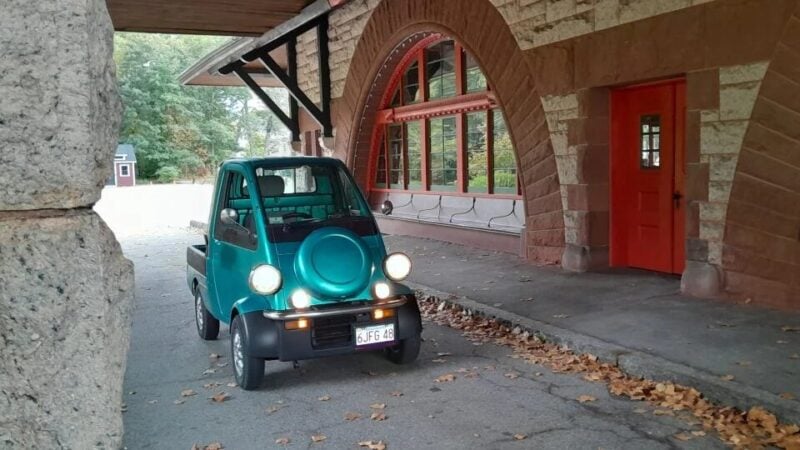
What’s it Like to Drive?
I wasn’t sure what to expect from driving a Midget II. My only access to it before the real deal arrived was its depiction in the Gran Turismo games, Tokyo Xtreme Racer Drift 2 and a mod for Assetto Corsa. From my cumulative experience with those sources, I had come to expect a driving experience characterized by a tremendous amount of body-roll along with heavy steering feel.
What I instead got was a combination of a go-kart and a truck. It generally behaves like a pickup truck over bumps and undulations in the road, thanks to its body-on-frame construction and rear leaf springs, but the short and narrow wheelbase means that even small bumps and dips that a larger car can handle comfortably wind up feeling like a bumpy roller coaster in the Midget.
Everything on the road is communicated to you through the entire truck, not just the seat, and it makes going the speed limit a frightening experience the first few times. There is one little problem in addition to this: the truck has no soundproofing. You will hear and feel everything it does through your seat, including how fast the engine is spinning. I suppose it justifies the lack of a tachometer, given the very direct feedback you get. The initial impression I got was that the Midget was going to rattle itself apart!
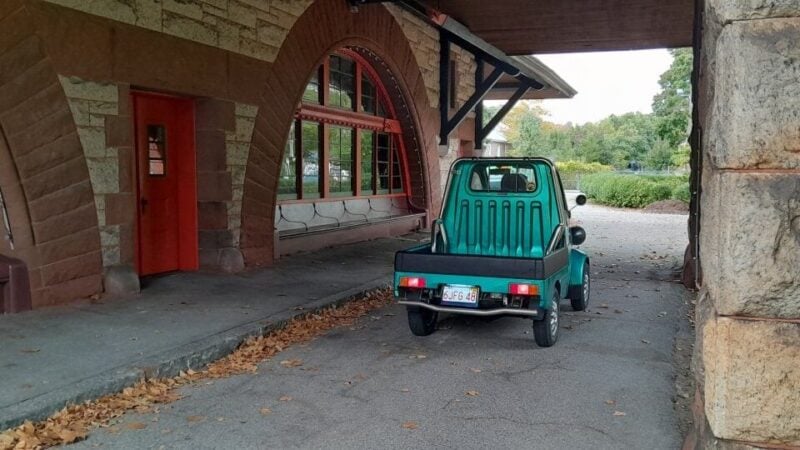
Once I got used to that sensation, though, I noticed that it is much more planted than it seems. Combine that with one of the lightest steering wheels I’ve ever handled in my life, no doubt in part thanks to the Midget weighing a mere 1200lb, and the result is a responsive, easy to manage car that feels as though it’s begging you to take it on a winding back road.
When you eventually cave in and do exactly that, the Midget II becomes an absolute delight to throw around. The very light steering paired with the lightweight body produces a very reactive, agile vehicle that’ll make 40mph feel like 80mph. It’s almost as if the Midget is goading you into going just a little faster, just a hair closer to its limit of grip – shame it doesn’t have the power to actually get there!
Helping this experience is the relative lack of body roll, with most of the “roll” feel coming from the driver sliding around on the flat, un-bolstered seat or being pinned to the right side door from the lateral Gs.
It terms of braking, the Midget only has drum brakes on all four corners but they’re perfectly adequate for the job and will stop the car quickly in an emergency.
The clutch is fairly firm and has an early bite point. Pairing this with the short first-gear makes the task of uphill starts very easy in the Midget II, although this driver’s ability to do so efficiently is still questionable…
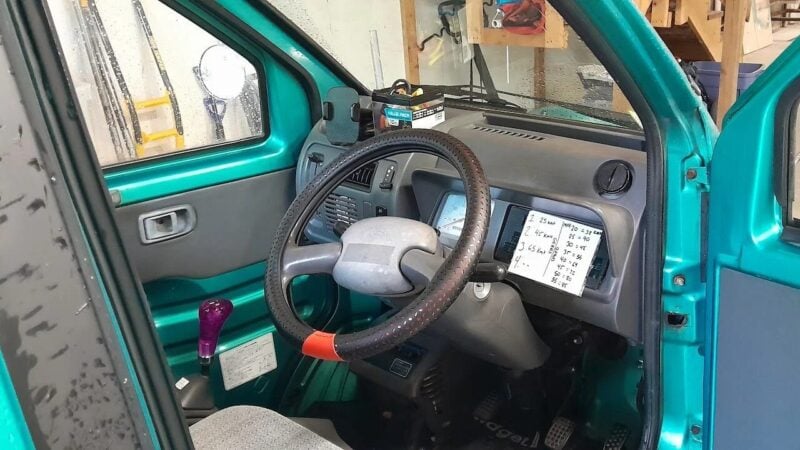
And on the Inside?
As unexpected as the ride is, the interior of the Midget II interior might be the more surprising aspect.
The first thing to get out of the way is that there isn’t much of an interior. You have a single seat, or 1.5 seats in an automatic. Your dashboard consists solely of a speedometer, a fuel gauge and a slot for the radio (or an actual radio, should you be luckier than I in your purchase).
Your accessory panel on the left has a single vent for the air conditioning, a large lever to select between air at your face and air at your feet with the defrosting function, a lever that selects three different air-conditioning strengths, and a single speaker for the radio. On the floor is a cooling unit which has its own selector lever for the strength of cold air you want coming out of the lone vent.
Tucked away under the AC lever on the left side is a small, two-position lever that selects if you want interior air cycling or exterior air. Buried deep in the footwell, behind the cooler and the clutch pedal, is a two position switch that redirects hot coolant into the air unit for heating the air.
More peculiar is the random cap sitting on the right hand side, above the dash. This cap is for the brake fluid system and fills a reservoir that is tucked away underneath the gray shell of the dashboard, necessitating that the entire dash be removed should the reservoir be damaged or need replacing.
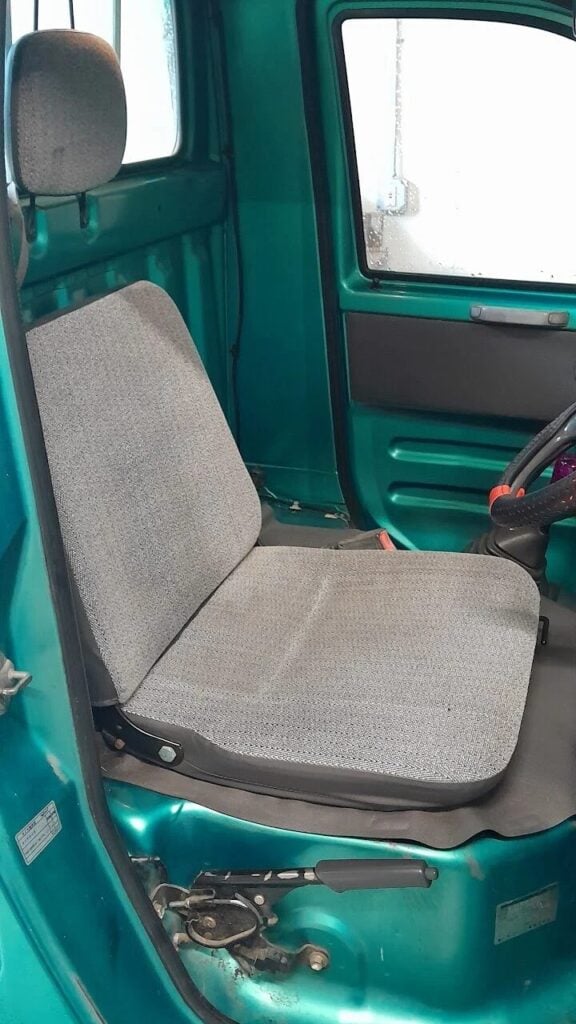
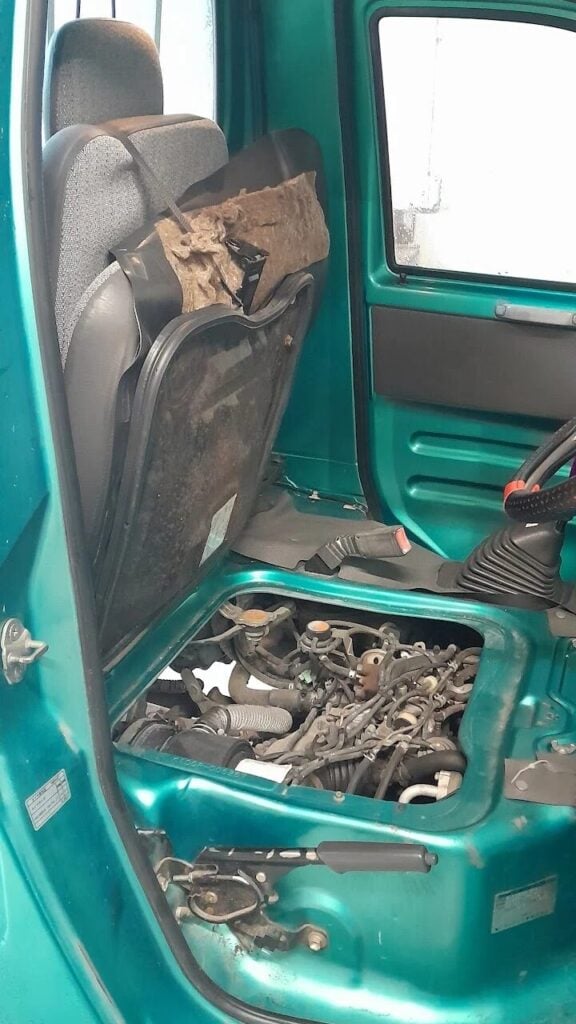
In addition to that, the engine is positioned underneath the driver’s seat. The seat, which is also acting as the bonnet for the Midget, will fold up and to the back of the cabin to facilitate engine access.
There is a second engine panel on the front of the seat base that enables access to the alternator and belts sitting at the end of the engine block. This is a simple hinged panel held in place by two wing nuts. The front panel is covered up by a large rubber cover when not in use. A third panel hidden in the left side of the vehicle grants access to the oil sump for changing the oil.
Moving back to the front of the cabin, the 14.5-inch, non-adjustable steering wheel sits very low and is positioned at a steep angle relative to your hands. Combined with the overall profile of the seat, you end up sitting very upright and with your hands essentially resting on your lap.
The pedals are small, but relatively easy to find by feel. My only gripe is that the clutch pedal is rather shallow compared to the other pedals which makes manipulating it very awkward for a person with large feet.
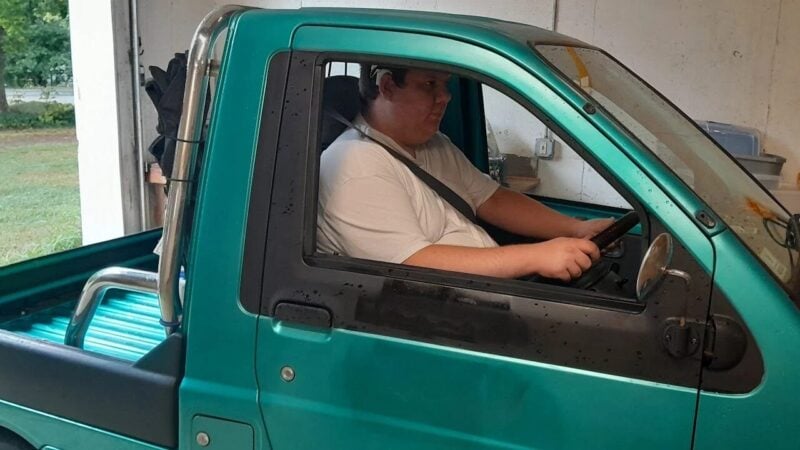
Overall space in the interior is, despite appearances, surprisingly roomy. I have sufficient headroom as a 5’11 person to not have to worry about hitting my head over bumps or when entering/exiting the car (an issue that I have quite frequently in my hardtop Miata). I also have ample clearance between the steering wheel, my torso and my legs despite being overweight.
The car is narrow enough that I can open both doors without moving from my seat. However, only the driver’s side window can be opened; the passenger side window is completely static. It’s a little odd to me as someone used to much larger cars to be able to open the opposing side door, but it can be a good thing in a country that is predominantly LHD. Imagine trying to go through a drive-thru in this car!
It may not be much to write home about, but it is a fully featured (less the tachometer) and functional interior that is more than adequate for a workhorse vehicle like the Midget II.

What do I Plan on Doing With it?
You know, I didn’t really think about a long-term plan with this car when I bought it. I wanted a Midget II strictly to have a Midget II — an iconic car from GT.
But now that I’ve put a lot of sweat, tears, and blood (I actually hurt myself at one point trying to work on it) into it, I have a better idea of what I plan on doing with it.
My family and I have already leveraged its capabilities as a small pickup to great effect around our property and will likely continue to do so from time to time. Besides that, I fully intend on giving the Midget II a fairly simple life here in the United States.
It will mostly be relegated to shorter drives around town, and fairly frequent visits to the Patriot Place Cruise Night during the year; come say hi if you spot me and my Midget!

How Much Does it Cost?
Depending on grade, type (Cargo or Pickup), and mileage, you can spend anywhere from $3,000 to $6,000 for a US-ready, average or close to stock Midget II.
That’s just for the vehicle though. You’ll need to add $2,000 for export fees, and another $1,600 for US import broker work and entry fees.
My example was, all in, roughly $7,900 from the seller to my door.
What are its Rivals?
In a general sense, every other kei truck and van that is available to import. Some truck examples include the Mitsubishi MiniCab, Suzuki Carry, Honda Acty, Subaru Sambar, and even its own sibling, the Daihatsu Hijet.
The Midget II, in terms of actual capabilities, isn’t as competent as its peers in the category. However, it was designed as a delivery vehicle and as a result ended up more popular with bar owners than with the intended audience; calling them rivals is not entirely fair. It occupies a very specific niche in an already niche market, and it’s hard to pin down exact rivals for it.
That said, it is also a cult classic, so there is arguably a unique market without many (or really any) rivals for it just on the basis of being the Midget II.
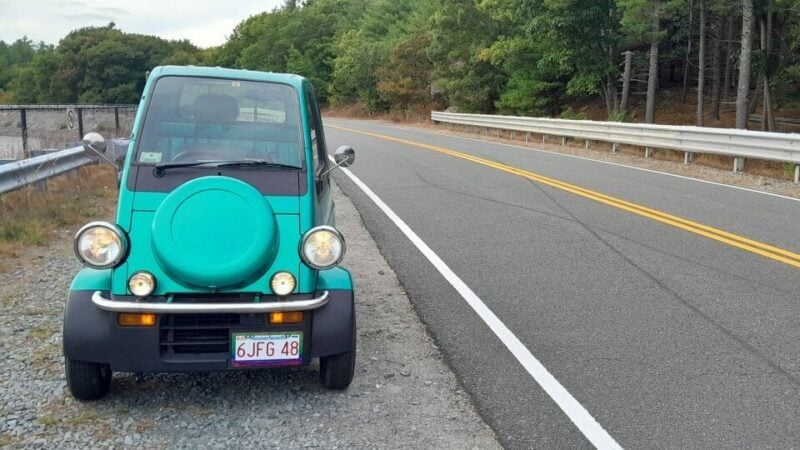
What’s the Verdict?
The Daihatsu Midget II is a very unusual car, even in a market segment filled with unusual cars. It’s a special, unique experience that will never fail to bring a smile to your face, even if your only exposure to it is as a passerby watching one go down the road.
It has been, as the owner of this particular example, simultaneously the most frustrating and most wonderful thing to happen to me. The Midget brings a smile to my face at every stop sign and every turn, and it elicits so many reactions from so many people.
That comes at the cost of some really unique logistical problems that come with being a rare car in a country where the manufacturer left 32 years ago. It’s hard to find parts, and even harder to secure them. There is also next to no documentation available, and what does exist was never translated into English.
If you are willing to deal with all of the problems that come with owning a 30-year old, obscure, low-volume JDM truck, then the Midget II is a worthwhile buy. It is a once-in-a-lifetime opportunity that you won’t regret once all is said and done.
See more articles on Road Test Review.










